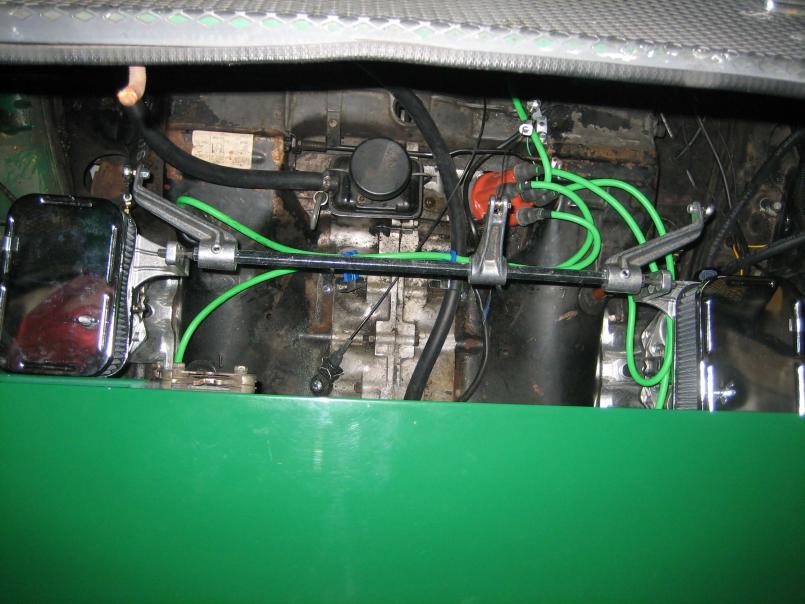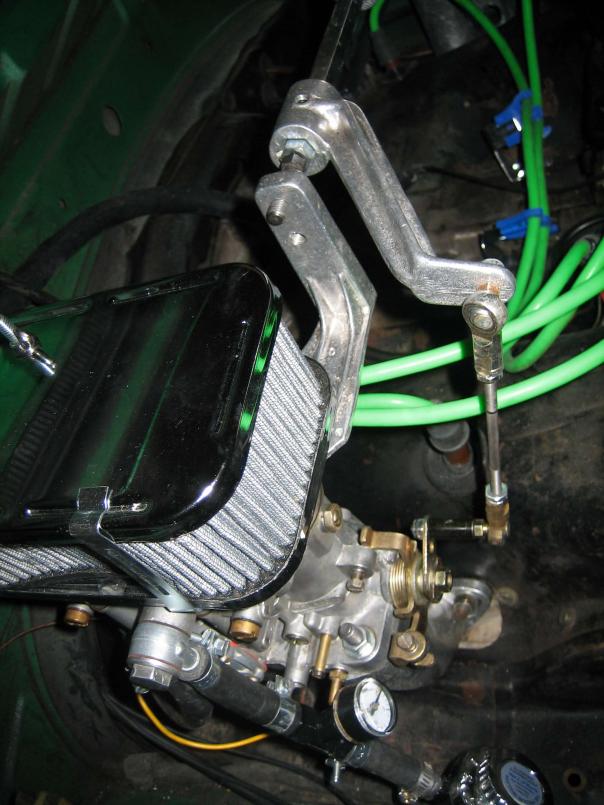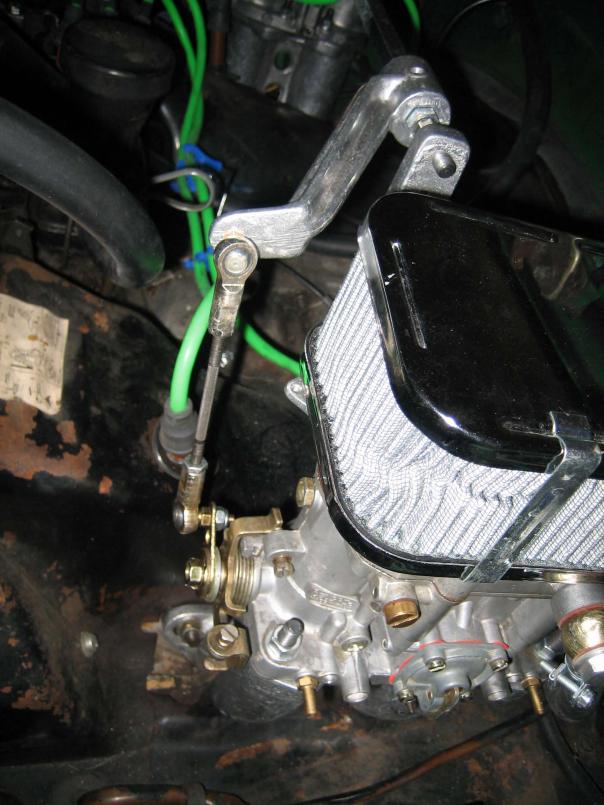Printable Version of Topic
Click here to view this topic in its original format
914World.com _ 914World Garage _ Dual carb question
Posted by: terrymason Jul 14 2007, 07:00 PM
The problem - The car will go very lean around 2500 rpm, as if the pump jets were too small.
History:
New fuel pump (3.5 PSI to each carb)
55 idle jets
55 pump jets
140 main jets
175 air correctors
These carbs are new to the car, and I'm trying to dial them in.
The car is lean when I first start it (16 / 17 on my air / fuel gauge), but then levels out to a nice 14.7 idle when warmed up. While driving, I can give the car 20% or so of the pedal, and drive up to highway speeds nicely, but when I goose it, it will go very lean (18-22 on my gauge) followed by a series of backfires and loss of power. I started off with 35 pump jets, and have moved up to 55s, which appear to be the most popular around here. I've also adjusted the pump jet linkage, from the nut fully loosened, and moved it in as far as it would go before affecting the main throttle shaft (like 60 turns or something).
What do you guys think, do I need 75 pump jets?
Posted by: Grelber Jul 14 2007, 08:37 PM
Send JR91472 a PM. He has a 1.8 w/ dual dell's, and could probably tell you what he's got in his.
Posted by: BxtrBill Jul 14 2007, 11:22 PM
40 Dells were usually equipped with 34mm venturis from the factory (hence the urban legend that 40 Dells flowed like 44 Webers which were also equipped with 34mm vents, but I digress)
The pump jets you have, being 55s, are probably enough to flat drown a 1.8 if you blip the throttle real quick a couple times. Just for reference, I've got 40 Dells on a 2056 with 30mm vents, 125 mains, 60 idles (CA gas, may it reek) and *40* pump jets. I could probably do with 35s just fine, but the 40s work, so they're staying. Your problem, whatever it is, is NOT due to the the size of the pump jets....the pump jets' function is to meter fuel when the accelerator pumps pump. They have nothing at all to do with steady-state running.
If I had that problem, I'd probably be looking at the idle jets first. Good rule of thumb is, most engines will run on the idles up to about 3000-3500 RPM or so. A plugged idle jet can make lean conditions, and the Dellorto design has them located where they can pick up any crap that makes it through/past the air cleaners.
HTH
Posted by: terrymason Jul 15 2007, 12:44 AM
I've tried quite a few idle jets from 46 to 60. I really don't think that the idle jets are clogged though, as I seem to change them constantly (just changed them from 52s yesterday). Just to be sure, I'll put my 60s in tomorrow.
You make a good point bringing up the venturis though - I have no idea what size mine are. I went into the garage and tried to check, but it looks like I'll have to take the carbs off the car to find out. Would the wrong size venturi cause these problems?
Posted by: Blood red 914-6gt Jul 15 2007, 01:12 AM
The problem is that dellortos suck. Sorry if you love them, but I have thrown three pairs in the can. I stick to Webers. Hope you figure everything out.
Posted by: Paul Illick Jul 15 2007, 05:23 AM
The problem is that dellortos suck. Sorry if you love them, but I have thrown three pairs in the can.
Speak for yourself on that one. Dellortos have always worked better than Webers for me.
When you have the carbs off the car fill the bowls and measure the volume of gas pumped out in one stroke of the throttle shaft. Then compare that throat to throat. I'll bet you've got something clogged, or your pump linkage either isn't right or isn't balanced side-to-side.
Posted by: type11969 Jul 15 2007, 07:18 AM
Terry-
You shouldn't be running that lean at startup or at idle . . . Im running 11.5:1 at idle, too rich for sure and I need to back it off, but 14.7:1 is only theoretically ideal, you need to be running in the 12 to 13 range (or less) for your car to be happy. 14.7 maybe on the highway, but talking to Charles at LN, he only sets up cars with Nickies that lean.
Right now on my 1.8 I have basically your same setup except with 180 airs and I am running 32mm vents. Check your vent size, if they are monsters you need to swap them out. I would actually rather be running 28mms, they may kill some top end but I know they would be more responsive than the 32s. You may want to swap out your airs, also check that you are running .2 etubes.
As for why you are running so lean when I have the same setup, well maybe due to vents/airs/etubes, but at idle I question that they would have that much of an effect. It seems like you either havea plugged idle jets or passages.
-Chris
The problem - The car will go very lean around 2500 rpm, as if the pump jets were too small.
History:
New fuel pump (3.5 PSI to each carb)
55 idle jets
55 pump jets
140 main jets
175 air correctors
These carbs are new to the car, and I'm trying to dial them in.
The car is lean when I first start it (16 / 17 on my air / fuel gauge), but then levels out to a nice 14.7 idle when warmed up. While driving, I can give the car 20% or so of the pedal, and drive up to highway speeds nicely, but when I goose it, it will go very lean (18-22 on my gauge) followed by a series of backfires and loss of power. I started off with 35 pump jets, and have moved up to 55s, which appear to be the most popular around here. I've also adjusted the pump jet linkage, from the nut fully loosened, and moved it in as far as it would go before affecting the main throttle shaft (like 60 turns or something).
What do you guys think, do I need 75 pump jets?
Posted by: terrymason Jul 15 2007, 05:26 PM
OK, I have made some big headway on this. I pulled all the jets from the car, and blew them out with carb cleaner, along with the places they go. Replaced my 52 idle jets with 60s.
I think cranked the idle up to 2500, and used my unisyn gauge to check the flow. The passenger was a 5, while the driver was at 12. I adjusted the linkage so that they are both at 11 around 2500 rpm.
I then addressed my mixture, making all screws 2.5 turns out.
I then adjusted my pump jets. turning them about midway out. They were previously all the way tightened (I was trying to get a larger pump squirt)
I finally closed all my air bypass screws.
Now, the car idles around 10.5 a/f (probably from the 60 idle jets). It drives 100% better, but still goes lean when it starts to pull (2nd gear feels it most). It also seems that if I goose the gas it will go lean.
Posted by: 904svo Jul 15 2007, 06:48 PM
Sounds like your venturis are too big for a smooth transistion from the idle circuit
to the main jets.
Posted by: BxtrBill Jul 15 2007, 08:12 PM
Ok...you got me on that one. The pump jets sit in holders that screw into the (outboard) side of the carb body.....there IS no adjustability, except to replace the jets with larger or smaller ones. Are we talking about the same jets here?
Your initial mixture screw setting is probably good for a starting point, and the somewhat "fat" idle mixture makes things less picky when you're trying to get a new carb set-up sorted out.
34mm vents still sound kinda huge to me for a 1.8, though....28mm would be more like it. An over-carbureted engine does not respond well to minor jetting changes. They sort of gasp and stumble and generally run poorly except at one magic combination of throttle setting and RPM. If it were me, I'd go to www.cbperformance.com and see what they have in the way of jets and venturis for the Dellortos. Used to be they carried a bunch of stuff, but they seem to be more into aftermarket FI these days. You may want to order up their Dellorto Book, if it's still in print. It can be helpful, especially if this is your first foray into carbs. Another possibility is European Motorworks in Hawthorne, CA...don't know their web address offhand, but Google does.. They carry a bunch of Dell (and Weber) parts.
And a couple other questions for you......have these carbs EVER worked correctly on this engine? Or, failing that, do you know anything of their history, as in, what were they used on? It sounds like they have an as-shipped set-up, so I'm just wondering. There are dang few NOS Dells floating around these days, so yours probably did time on another engine before you got them...if you bought them from a friend who used them, maybe he'll be able to shed some light on things?
One more question....what was the reason for going to carbs in the first place?
If it was to replace a cranky FI installation, was the engine otherwise in good shape? Good compression...good tune-up specs...timing, valve adjustments, etc?
I'm curious, too, to learn what you're using for a distributor. Lotsa carb guys just stick in a 009 and call it good, and suffice it to say there are whole WORLDS of things that work better than those. The stock dizzy for a 1.8 isn't a bad choice, but it might benefit from some changes to the advance curve.
Sounds like you're making progress, though. Keep us posted.
Posted by: type11969 Jul 15 2007, 08:48 PM
Did you ever check out the vent size?
You should not be adjusting the linkage to balance the carbs, the carbs have to be balanced with the linkage disconnected. Once balanced, the linkage gets reconnected, and you try to make sure both carbs open and close at the same time and at the same rate.
Once at highway rpms, are you still running lean? Or only when accelerating? If it is the latter, it could be due to oversized vents but you may be able to correct for it with the pump shot. Verify your vent size, consider jumping up to 180 airs, and check your e-tubes. You also should try to measure your pump volume, you should gun for at least .2 ccs per two pumps.
The smallest vents CB had as of a month ago were 32s, they will be better than 34s for you (if you actually are running 34s).
-Chris
OK, I have made some big headway on this. I pulled all the jets from the car, and blew them out with carb cleaner, along with the places they go. Replaced my 52 idle jets with 60s.
I think cranked the idle up to 2500, and used my unisyn gauge to check the flow. The passenger was a 5, while the driver was at 12. I adjusted the linkage so that they are both at 11 around 2500 rpm.
I then addressed my mixture, making all screws 2.5 turns out.
I then adjusted my pump jets. turning them about midway out. They were previously all the way tightened (I was trying to get a larger pump squirt)
I finally closed all my air bypass screws.
Now, the car idles around 10.5 a/f (probably from the 60 idle jets). It drives 100% better, but still goes lean when it starts to pull (2nd gear feels it most). It also seems that if I goose the gas it will go lean.
Posted by: BxtrBill Jul 15 2007, 09:12 PM
[/quote]The smallest vents CB had as of a month ago were 32s, they will be better than 34s for you (if you actually are running 34s).
The vents for the 36mm Dells also fit the 40s (same carb body), and you can get them down to 28mm at least. Just a thought. Can't say if CB has them, though.
Oh..almost forgot.....if you look down the carb throat at the top edge of the venturi, you'll see a number that indicates the venturi size.
Posted by: terrymason Jul 15 2007, 09:15 PM
Ok...you got me on that one. The pump jets sit in holders that screw into the (outboard) side of the carb body.....there IS no adjustability, except to replace the jets with larger or smaller ones. Are we talking about the same jets here?
....
And a couple other questions for you......have these carbs EVER worked correctly on this engine? Or, failing that, do you know anything of their history, as in, what were they used on? It sounds like they have an as-shipped set-up, so I'm just wondering. There are dang few NOS Dells floating around these days, so yours probably did time on another engine before you got them...if you bought them from a friend who used them, maybe he'll be able to shed some light on things?
One more question....what was the reason for going to carbs in the first place?
If it was to replace a cranky FI installation, was the engine otherwise in good shape? Good compression...good tune-up specs...timing, valve adjustments, etc?
I'm curious, too, to learn what you're using for a distributor. Lotsa carb guys just stick in a 009 and call it good, and suffice it to say there are whole WORLDS of things that work better than those. The stock dizzy for a 1.8 isn't a bad choice, but it might benefit from some changes to the advance curve.
Sounds like you're making progress, though. Keep us posted.
- below the pump diaphram there is an adjustment (nut on a rod). I was under the impression that adjusting this changed the volume that was produced by a single squirt of the jet. I believe that I'll have to take the carbs off, and measure a squirt to make sure it's accurate.
As to the history of the carbs, I am replacing a single progressive carb with these dual dells. I purchased them fully rebuilt, and have been fighting a learning curve the whole time. I thougth that I would just bolt the on and go, but have ended up learning alot about the carbs. I'm currently using an 009 that came with the car.
Thanks for all the help - I'm about to go out of town for the week, so it will be a while until I can work on it again.
Posted by: terrymason Jul 15 2007, 09:18 PM
Oh..almost forgot.....if you look down the carb throat at the top edge of the venturi, you'll see a number that indicates the venturi size.
Are you sure, or is it possible to put the in upside down, so that the numbers are at the bottom? I took a flashlight and stared at them for about 5 minutes and couldn't see anything.
Posted by: terrymason Jul 15 2007, 09:25 PM
Did you ever check out the vent size?
You should not be adjusting the linkage to balance the carbs, the carbs have to be balanced with the linkage disconnected. Once balanced, the linkage gets reconnected, and you try to make sure both carbs open and close at the same time and at the same rate.
Once at highway rpms, are you still running lean? Or only when accelerating? If it is the latter, it could be due to oversized vents but you may be able to correct for it with the pump shot. Verify your vent size, consider jumping up to 180 airs, and check your e-tubes. You also should try to measure your pump volume, you should gun for at least .2 ccs per two pumps.
The smallest vents CB had as of a month ago were 32s, they will be better than 34s for you (if you actually are running 34s).
-Chris
Haven't checked the vent size yet.
I balanced the carbs with the linkage off, and everything was cool. They would idle and flow the same. I then hooked the linkage up, and it appears that the linkage to the passenger was longer, so that they were fine at idle (the speed screw kept it open), then when I revved the engine, the driver side would be opened further. Does that make sense? I think I just had some slop in the linkage.
once at highway speeds I'm fine. I am probably rich at idle and rich on the highway, but whenever I press the pedal quickly I go very lean for about 3 - 4 seconds, along with hesitation. The engine then levels out and is fine.
I've ordered some 185 and 200 airs, and have checked the emulsion tube. I have a 9164.1 tube, but the guy that sold them to me said "I drilled them out, so they are they same as the 9164.2". Does that sound right?
Posted by: type11969 Jul 16 2007, 07:00 AM
You gotta try to adjust the linkage such that the linkage opens the butterflys at the same rate and opens/closes them at the same time. That way you know they are sync'ed throughout the rev range. Syncing them with the linkage on at 2500 rpm probably means that they are only synced at 2500 rpm.
The accel hesistation may also be due to the 009. Its a pretty crappy dist. It is more likely to be due to large vents and maybe a small pump shot (you are right about how to adjust it). Try to measure the volume, make sure both sides are balanced and close to .2ccs per two strokes.
I'm pretty sure the dell manual recommends 180 airs for most applications, you could order the reamer kit and open up your 175s. I'm not entirely sure how the airs come into play in the whole scheme of things, but messing with it may clear up that transistion problem you have.
You can't "drill out" a .1 to a .2. You have to plug certain holes. I went through this ordeal with some poorly modded .1s that were supposed to mimic .2s. There are two upper holes you have to plug in order to get the .1s to be close to .2s. The raised middle band of the .2s is slightly larger than the .1s, but at 20+ dollars a piece, I'm getting by with the plugged .1s.
These pics should give you an idea about what has to be plugged. Hopefully whoever "drilled" them didn't actually drill them!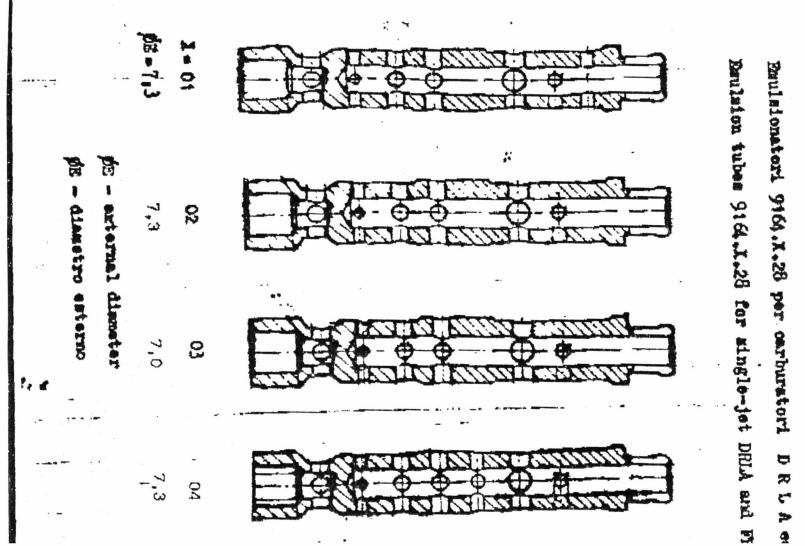
Haven't checked the vent size yet.
I balanced the carbs with the linkage off, and everything was cool. They would idle and flow the same. I then hooked the linkage up, and it appears that the linkage to the passenger was longer, so that they were fine at idle (the speed screw kept it open), then when I revved the engine, the driver side would be opened further. Does that make sense? I think I just had some slop in the linkage.
once at highway speeds I'm fine. I am probably rich at idle and rich on the highway, but whenever I press the pedal quickly I go very lean for about 3 - 4 seconds, along with hesitation. The engine then levels out and is fine.
I've ordered some 185 and 200 airs, and have checked the emulsion tube. I have a 9164.1 tube, but the guy that sold them to me said "I drilled them out, so they are they same as the 9164.2". Does that sound right?
Posted by: type11969 Jul 16 2007, 07:02 AM
.1, .2, .3, .4 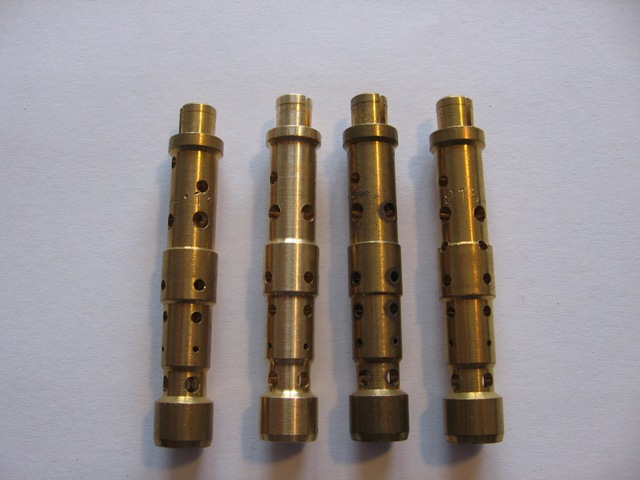
Posted by: 9146986 Jul 16 2007, 07:41 AM
Going lean at 2500 probably isn't a function of accelerator pump.
I don't know Dells, but with Webers you are right at the transition between the idle and main jets.
Posted by: rhodyguy Jul 16 2007, 09:02 AM
i disagree with the "you should not be adjusting the linkage to balance the carbs" comment. by balance i presume you mean same rate of flow. you need common initial settings across the board. air bypass (closed or open), idle air mixture screws...the angularity of the linkage arms and drop links should be as similar as possible. if you have both of the idle adj screws making contact with the stops, and the linkage is out of whack, you'll prob notice difficulty sustaining a stable idle with an equal indicated flow rate. back one of the idle screws of its stop. this will allow you to match the 'free' carb flow to the other by simply turning the thread linkage rod in or out while monitoring the most forward venturis on either carb. you can increase the idle speed with the single screw. now check all 4 vents. this is where the air bypass screws come into play if there is a discrepancy. turn the idle back down. adj the idle air mixture screws. you need to be patient. a little adj can take a long moment to have full effect.
you need to inspect your linkage if the flow rate is constantly changing thru the range of motion. worn heim joints that rattle around and just plain slop makes setting the carbs up a hopeless and frustrating task.
k
Posted by: type11969 Jul 16 2007, 09:31 AM
This is what I mean. Linkage disconnected, pull out the unisyn or preferably the scroll type balancing tool. Match the flow rates of both sides by adjusting the idle speed screw. Match the flow rates of all the barells with the idle air bypasses (if you really want to be sync'ed). Put the sync tool away, the linkage cannot and should not be set up such that it will mess with the syncing of the carbs, it should be set up such that it maintains the initial sync. Connect the linkage such that the butterflys open and shut at the same time and the same rate. You will need to mess with the length of the linkage and may need to shim it to get the angles to match from side to side. Now, with the flow rates the same through the rev range, you can mess with the mixture screws to dial in the fuel for each barell.
The linkage does not come into play when the idle screws are touching the stops. If you synced the carbs properly, the flow rates of the carbs will be the same at any throttle position if both carbs are open to that same position. The catch is whether or not the linkage is opening the carbs up to the same position at the same time.
i disagree with the "you should not be adjusting the linkage to balance the carbs" comment. by balance i presume you mean same rate of flow. you need common initial settings across the board. air bypass (closed or open), idle air mixture screws...the angularity of the linkage arms and drop links should be as similar as possible. if you have both of the idle adj screws making contact with the stops, and the linkage is out of whack, you'll prob notice difficulty sustaining a stable idle with an equal indicated flow rate. back one of the idle screws of its stop. this will allow you to match the 'free' carb flow to the other by simply turning the thread linkage rod in or out while monitoring the most forward venturis on either carb. you can increase the idle speed with the single screw. now check all 4 vents. this is where the air bypass screws come into play if there is a discrepancy. turn the idle back down. adj the idle air mixture screws. you need to be patient. a little adj can take a long moment to have full effect.
you need to inspect your linkage if the flow rate is constantly changing thru the range of motion. worn heim joints that rattle around and just plain slop makes setting the carbs up a hopeless and frustrating task.
k
Posted by: rhodyguy Jul 16 2007, 10:04 AM
the linkage ABOSOLUTELY comes into play when the idle speed adj screws are resting on the stops. when sitting static, a misadj linkage can push/hold one side open further than the other. just one of the screws resting against its stop will control the idle speed. they do cease to have any effect when the carbs are open to the point where they are both off their stops. if the throttle plate openings are unmatched whether at idle or wot your car isn't going to run right. you want to make sure everything is connected when the side to side flow is matched at the base, common step up.
k
Posted by: type11969 Jul 16 2007, 10:22 AM
Wait, if both idle speed adjusting screws are resting on their stops, how can the linkage hold one side more open than the other? Both screws are resting on their stops. When sitting static, the linkage should not be applying a twisting force to either butterfly! If you are suggesting that the linkage is holding one screw off the stop while the other is on, well, your linkage is out of adjustment and, obviously, both screws are not on their stops. If you spin the one screw that is not on the stop to meet the linkage then the flows are no longer balanced.
If you match the flow with the linkage disconnected (idle speed screws fully seated on the stops), then you connect the linkage such that it matches the butterfly positions of both carbs throughout the rev range, the flow will be matched throughout the rev range. I don't know how else to explain it. The linkage's only function is to make sure that both butterflies are in the same place at the same time, it should not be used to match the flow of the two carbs at any one point, because at any other point it may no longer be matching the flow.
the linkage ABOSOLUTELY comes into play when the idle speed adj screws are resting on the stops. when sitting static, a misadj linkage can push/hold one side open further than the other. just one of the screws resting against its stop will control the idle speed. they do cease to have any effect when the carbs are open to the point where they are both off their stops. if the throttle plate openings are unmatched whether at idle or wot your car isn't going to run right. you want to make sure everything connected when the flow is matched.
k
Posted by: rhodyguy Jul 16 2007, 10:39 AM
ok. linkage off. flow set the same side to side with the idle adj screws. now attach the rods with one of them longer than the other and touch nothing else. check the flow rate now!! a c-note says it's off. flow is flow. with the throttle plate opening the same at idle it will be, or should be, the same throughout range of operation
on a side note, not all webers are 'built' the same. some have 'helper' springs on the outside of the throttle plate bars and some don't. w/o the helper springs, linkage disconnected (this means no cable return spring), start the car. bottom line, do what works best for you. my method works swell for me. my carbs don't snap or pop, nor does my car backfire on decel.
k
Posted by: type11969 Jul 16 2007, 11:29 AM
Well, if one rod is longer than the other and it forces the throttle plate open on one side, then the linkage IS NOT adjusted properly, now is it? It is interfering with the initial settings and should not be. Obviously the flow will be different because one plate is open more than the other (thanks for the really tempting wager though). It would be at this point that I adjust the linkage such that the idle screws are resting on their stops (matching the initial sync), then I would verify that the butterflies both open fully and at the same rate.
What I am doing is setting my linkage about my initial position. What you are doing is setting your initial position about your linkage. Which one takes more fiddlin I don't know.
Snapping, popping, or backfiring usually is not a sign of a poorly set up linkage, but I am glad your car doesn't suffer from any of those maladies.
-Chris
ok. linkage off. flow set the same side to side with the idle adj screws. now attach the rods with one of them longer than the other and touch nothing else. check the flow rate now!! a c-note says it's off. flow is flow. with the throttle plate opening the same at idle it will be, or should be, the same throughout range of operation
on a side note, not all webers are 'built' the same. some have 'helper' springs on the outside of the throttle plate bars and some don't. w/o the helper springs, linkage disconnected (this means no cable return spring), start the car. bottom line, do what works best for you. my method works swell for me. my carbs don't snap or pop, nor does my car backfire on decel.
k
Posted by: Joe Ricard Jul 16 2007, 12:10 PM
So what are we betting here?
What Kevin is saying is pretty good to get you in the ball park.
However if you really want to be precise you should adjust the linkage one step further than stated above.
now that you have the idle stops adjusted there is no promise of the throttle plates being synched up once you push on the gas pedal.
The machining of CB linkage and several others is just not that accurate. What you are dealing with is differing length from throttle shaft to the point where your spherical bearing linkage arm connects.
I have had to slot one or both arms to match up the mechanical advantage so the throttles stay perfectly synched thru the entire arch of movement.
Then I always set the throttles to be synched at 3000 RPM pulling on the cable and using a synch tool. Close enough is not good enough for me.
Once I get this far I let the linkage settle back on the idle stops and see where they sit synch wise. you can now adjust them perfectly while leaving the linkage alone. Most CB type linkage has enough slop to allow this.
I have a Billet custom piece that is very tight. if you breath on one side it moves the other.
Posted by: rhodyguy Jul 16 2007, 12:28 PM
i'm glad you see what i'm getting at joe. my method just eliminates a step or 2. with the off stop side hanging, you either tighten up or loosen the rod to match the other carb. you can really make minute adjustments. i don't give a shit what one idle screw is doing at this point as long as it's not 'in the way'. it's removed from the equation. when all is said and done, the backed off screw is run in til' it just makes contact and starts to increase the idle speed then off a bit. increasing the idle to stop the indicator in the unisyn from fluctuating is VERY important. you increase yours more than i do. i go just enough to steady the needle. if it dances even the least istsy, bitsy, teeny, tiny bit, i turn the idle up. as stated...do what works best for you. ![]()
k
Posted by: type11969 Jul 16 2007, 12:34 PM
The bet was if you sync the carbs with the linkage off (idle screws on the stops) that if you attach the linkage, and the linkage is set such that it pulls one of the idle screws off the stops, that the carbs would not still be flowing at the same rate. Hmm, still debating if I should take it ![]()
Anyway, "my" method works fine, and I believe it is how most VW guys do it. Here is a more in-depth explanation if you are interested:
http://www.aircooled.net/gnrlsite/resource/articles/dualcarb.htm
Posted by: BxtrBill Jul 16 2007, 09:47 PM
Hm..hadn't considered someone might put them in upside down, but it's entirely possible to do so. I can't say what to expect from an upside-down venturi, but I'd be fairly certain the carb(s) wouldn't work as designed....I'd guess it would upset airflow by moving the low-pressure area of the venturi lower in the carb, but I never tried it so don't know what to expect. Before you do anything else, it may be worthwhile to check one more time for the numbers.....they're small, but they *should* be there. If they're not, someone has reversed the vents in the carb body, maybe the same guy who "drilled out" the emulsion tubes (hint: don't ever do that) Emulsion tubes, in concert with the air correction and main jets, control mixture in relation to airflow. E-tubes are available to lean or richen the mixture at different spots in the rev range, but generally you're best off with the tubes that came with the carbs. You should be fine with 180 airs, too....you can go to 200s and that will have the effect of leaning the mixture slightly across the range, but to no real advantage.
It's easy to remove, then reinstall the vents correctly. Remove the air cleaners and the top cover of the carburetor. If you're really brave, do this while the carb is still on the engine. I'm not that brave, so I do this on a bench. There is a set screw with locknut at each end of the carb body....loosen the locknut, then the setscrew, and remove the aux (boost) venturis, then the pump jets. If the carbs have been cleaned recently, the main venturis should slide right out...if not, they may take a bit of gentle persuasion. Nothing drastic, please...they're just potmetal. Stick 'em back in with the numbers toward the top side of the carb, and screw everything back together. Or as the Haynes says, "Assembly is the reverse of disassembly"
One thing I'd add.....when you're trying to troubleshoot something like this, Change One Thing At A Time. Focus on one part of the problem...the idle....midrange, transition, high-speed running, acceleration, etc, insofar as possible. Carb functions overlap, granted, but it's a real booger to guage the effects (if any) of a change when two or three things changed at once. Ok...off the soapbox now, and you probably knew that anyway.
Posted by: terrymason Jul 17 2007, 12:48 AM
I'm working in Seattle all this week, so won't get to make any changes to the car, but I did snap off a few photos before I left.
Here are my etubes, and a shot down the mouth of one of my carbs. Just so that I'm not loosing it, the main venturi is the large sleeve that the red arrows are pointed at right?
Attached image(s)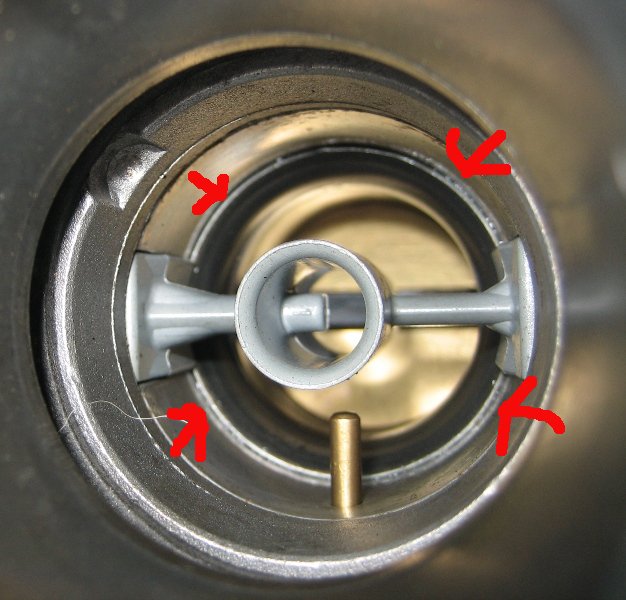
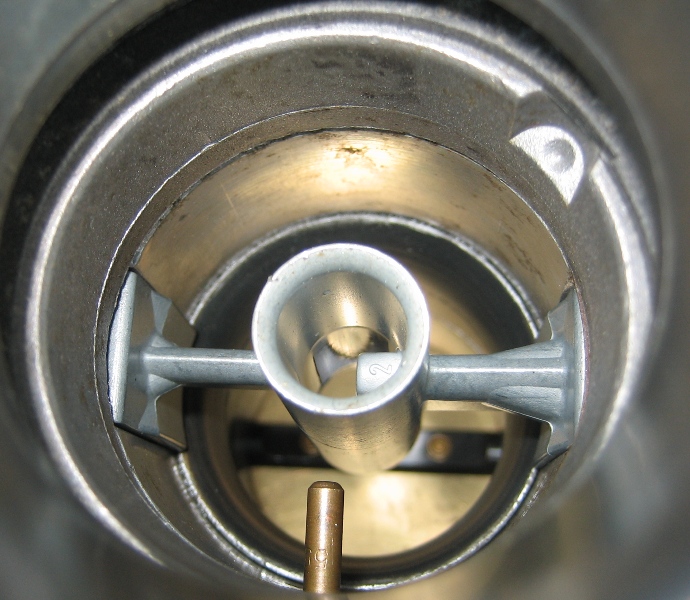
Posted by: terrymason Jul 17 2007, 12:51 AM
etubes
Attached image(s)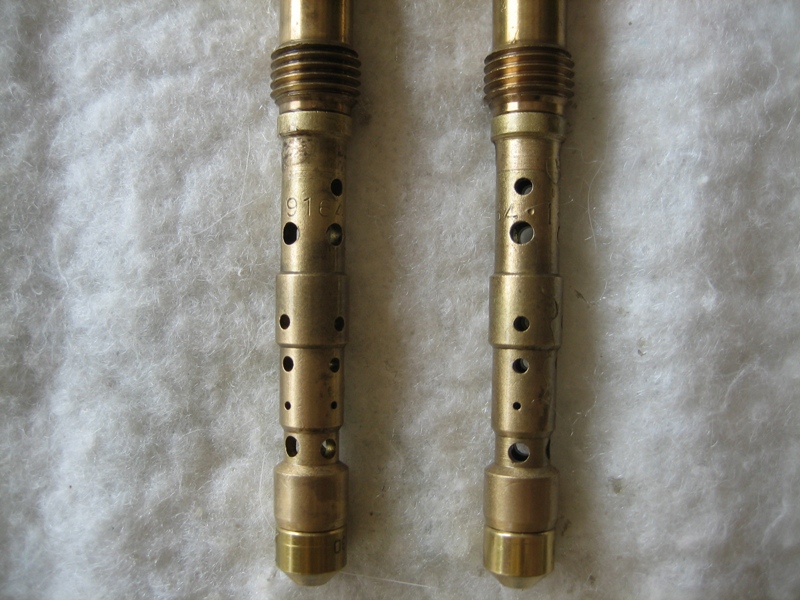
Posted by: type11969 Jul 17 2007, 07:22 AM
Looks like at least that one etube had one of the proper holes soldered shut at the top, check to make sure that is the case all around.
Yes, that is your vent.
-Chris
Posted by: Joe Ricard Jul 17 2007, 04:13 PM
Them aren't webers are they.
At least they look nothing like either my 40 or 44 IDF's
Posted by: BxtrBill Jul 17 2007, 10:04 PM
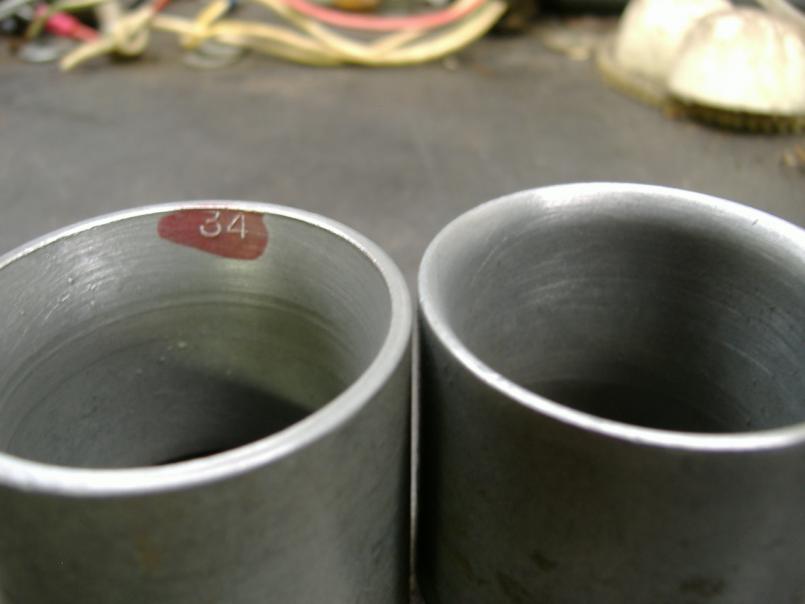 Here's a pic of the venturi out of the carb....the one on the left shows the number (with a bit of highlight...they can be a booger to see) and is "right side up", or the way it would be installed in the carb. The right one is upside down and you can see the fairly pronounced radius on the bottom end. This would be nearest the throttle plates when installed.
Here's a pic of the venturi out of the carb....the one on the left shows the number (with a bit of highlight...they can be a booger to see) and is "right side up", or the way it would be installed in the carb. The right one is upside down and you can see the fairly pronounced radius on the bottom end. This would be nearest the throttle plates when installed.
Of course it's always possible someone removed the numbers.....there's a fun thought.
Posted by: terrymason Jul 17 2007, 11:29 PM
So, there's a blunt end, and a tapered end? Thank you very much for the photo. I've ordered some 30s (even though I'm not exactly sure what I currently have). I'll install them when I'm back in town, and verify that everything is pointed in the correct direction.
Posted by: Twystd1 Jul 18 2007, 03:06 AM
I just went through this with some other 914 bretheren.
You will NEVER get the carbs dialed in right with an 009 distributor.
Unless you have the 009 dialed in and curved PERFECTLY for a type IV engine. And I don't care if you have a crane, points or Pertronix in it.
Nobody believes me until they stick in an stock type IV or Mallory distributor.
Then re-dial in the carbs and the engine runs right for the first time.
Many companys sell a 009 dizzy supposedly setup for the type IV engine.
So far... In my experience.... It's total bullshit.
I have yet to see a 009 from any company that is correctly curved for a type IV engine. They suck... Toss it. A used bone stock dizzy is better.
And you won't be tuning your carbs around a screwed up ignition curve and inaccurate dwell.
Try it... You will like it.
I gave my last three stock dizzys away just to prove it. As these three guys had the much of the same carb tuning problems. Once the correct ignition curve was there for the type IV. The tuning issues were much easier to fix.
That is my experience. Yours may well be different.
Regards,
Clayton
PS: I hate 009 They are a bane to the 914 society. There ought to be a law against em in the type IV world. That goes for progressive webers as well.
Posted by: Joe Ricard Jul 18 2007, 06:00 AM
That' odd having the blunt end of the Venturi on the inlet side.
Weber carbs have the taper on top. which makes more aero dynamice sense.
Posted by: type11969 Jul 18 2007, 07:03 AM
I'm pretty sure that is reversed, I'm almost 100% sure the vents in my dells are installed with the radiused edge pointing up.
Posted by: BxtrBill Jul 18 2007, 11:14 PM
I'm pretty sure that is reversed, I'm almost 100% sure the vents in my dells are installed with the radiused edge pointing up.
Quite right...don't know what I was thinking (or IF I was thinking) about the radiused edge. Turns out *some* OE Dell vents have the number on the radiused edge and some have it on the "straight" end. Checked the ones in the white car (Dell 40s) and they're right up top on the radius.....checked a still-in-the-box set of Weber 44IDFs and they're in the same place. Checked the 40IDFs on the blue car and, sure enough, the number is on the radius. Sorry for the confusion.
Posted by: terrymason Jul 22 2007, 09:33 PM
I'm back in town, and had some time to look at my Dells. I took out the venturis, and I was finally able to find a 34 etched by hand on one end of each. It looks like they were larger, then were milled down.
I'm still waiting on my new 30 venturis. and will report back when I get them
Posted by: rhodyguy Jul 22 2007, 09:51 PM
i think your car is going to perform vastly better running a set of carbs with smaller venturis.
k
Posted by: Joe Ricard Jul 23 2007, 08:42 AM
Agreed, it "should" pull better down low.
And you will probably not run out of power all the way to 5800 RPM.
Above that and you need lots of internal engine work anyway.
Posted by: jr91472 Jul 23 2007, 08:48 AM
Clayton is spot on regarding the dizzy. Go stock with the vac advance connected. I also upgraded it with the Crane Fireball ignition system.
I have hardly touched the carbs since....
Posted by: rhodyguy Jul 23 2007, 08:53 AM
your next decission is which intakes to run. i posed the ? re short vs tall for a f.i 2.0 engine and 40idf. len hoffman said to go with the talls for better top end performance. better power down low with the short intakes. my car is more of a highway runner. i went with the talls. keep us updated with your results. too often, we never hear the end of the story.
k
Posted by: jr91472 Jul 23 2007, 08:57 AM
Yes please. I want to hear how the 30 vents work. I went with 32s on my 1.8L / Dell combo. Runs really really well, but if 30' are better ![]()
keep us updated with your results. too often, we never hear the end of the story.
k
Posted by: BxtrBill Jul 23 2007, 09:48 PM
I'm still waiting on my new 30 venturis. and will report back when I get them
You might want to order some smaller main jets while you're at it....those 140s are gonna be way on the rich side, especially with the 175 airs. Rule-of-thumb says 120s should work...125s may be better. Too lean typically ain't good.
Posted by: mike373 Jul 23 2007, 11:03 PM
Hey rhodyguy. I think you may have the manifold info backwards. I heard tall manifolds for low and midrange performance. Creates more port velocity.
Mike
Posted by: terrymason Aug 2 2007, 12:23 PM
well, I've made alot of progress! I have installed new 30 venturis, and re-adjusted the linkage (one side was about vertical, while the other was a an angle). The car no longer backfires, and runs much better, but it does still go lean when switching from idle to main circuit.
I noticed that the auxiliary venturi (the tube over top of the main venturi) don't all match. 3 of them have the number 2 stamped on them, while one has the number 1 on it. I'm assuming that this is a measurement of some sort right? What size should I want? Any idea what this would cause?
Thanks guys! It's great to have my car running again!
Posted by: terrymason Aug 2 2007, 02:40 PM
You can actually see the aux venturi below
Attached image(s)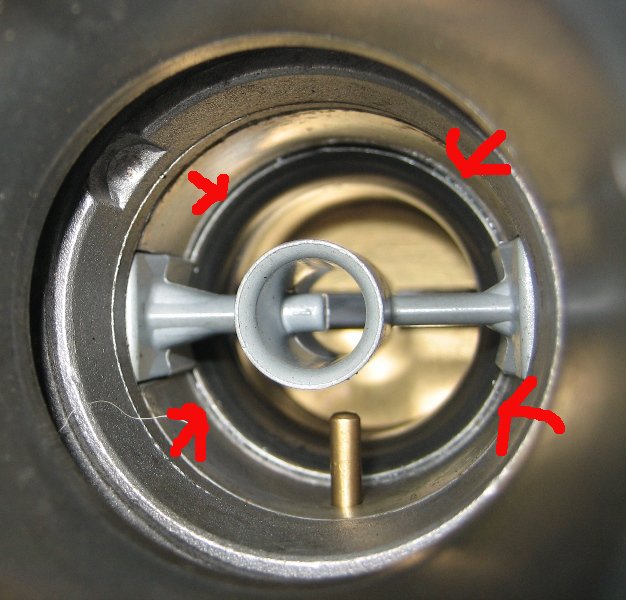
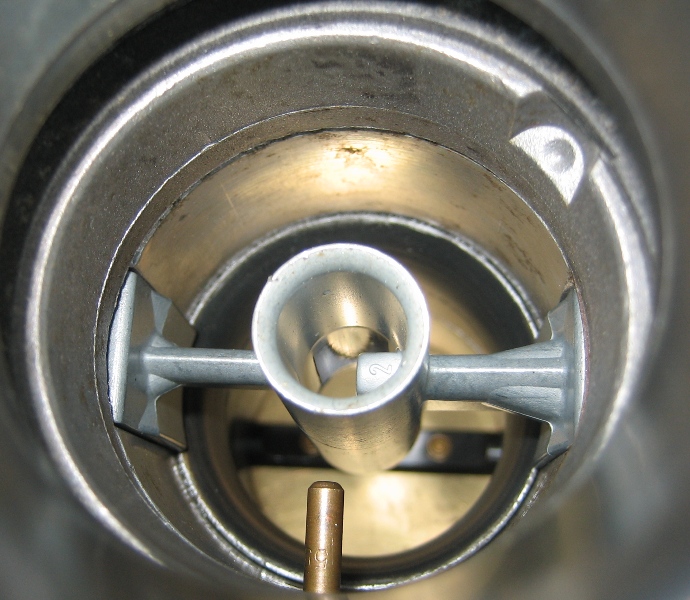
Posted by: eric914 Aug 2 2007, 03:01 PM
Not to hijack but I have 40 IDF's with an 009 dist. If I put the factory dist back on where do I port the vacuum from. Can I use one of the ports at the base of the carb? Do I need to connect the ports from both carbs together to keep the flow through them the same? I am also having some backfire issues and the motor seems flat when accelerated hard in the 3500+rpm range.
Posted by: 9146986 Aug 2 2007, 07:03 PM
I remember hearing that the best stock dist to run is the 1.8 with the vacuum pot connected. Can anyone back this up?
You are getting good advice here. You have made double sure that the drop links for both sides are dead nuts the same length right? Both sides have the same angle and hit full open throttle at the same time, as well as both resting on the idle stops? There's some pretty schlockey linkages out there, and Joe's dead on with how important the linkage set up is.
I don't know Dells, but I'd try just larger idles, or just larger mains first, but probably not both at the same time.
Where are your mixture screws set at? If you have to set the mixture less than 1 1/2 turns out then I'd try larger main jets, and smaller mains if you've got to go more than 3 1/2 turns out.
Posted by: BxtrBill Aug 6 2007, 09:19 PM
[quote][quote name='eric914' date='Aug 2 2007, 02:01 PM' post='930974']
Not to hijack but I have 40 IDF's with an 009 dist. If I put the factory dist back on where do I port the vacuum from. Can I use one of the ports at the base of the carb? Do I need to connect the ports from both carbs together to keep the flow through them the same? I am also having some backfire issues and the motor seems flat when accelerated hard in the 3500+rpm range.
[/quote]
Well, seein' as how the hijacking has already been done (and also seein' as how other folks might want to know), vacuum for the distributor advance is always taken from a point ABOVE the throttle plates. If you have the later version of 40IDFs (hecho en Espana, I believe?), they will have one port on each carburetor that you can use for this, Seems to me the earlier (Italian) versions have none, but I could be wrong....been a while. In any event, do not use any port that is below the level of the throttle plates unless you need to feed a vacuum retard can.
You can parallel the vac ports on the two carbs and I do, when I have two to use.
Lots of Dellorto pairs have only one vac port on one carb and I'll be danged if I can tell the difference.
I've used the stock 1.8 dizzy and I think it's a good choice for a carbed car. That said, I like the -205 distributors from early Jettas/Rabbits/whatnot, though they do require a bit of lathe time to make them work. A distributor from a later Bus will work too, and slips right into the hole in the case. The neat thing about these options is the bulletproof FACTORY electronic ignition that comes as part of the package. I fiddle with the advance curve some, set the timing and pretty much never look at them again. If you go this route, be sure to get the so-called Fairchild module, the special coil and the wiring harness to connect everything together.
Posted by: Twystd1 Aug 6 2007, 10:08 PM
If you choose to use a factory vacuum advance 914 Bosch dizzy on carbed engines.
NOTE: You can run a pertronix or Crane electronic setup in any of these dizzys. And thats a good thing IMnonHO.
You have a couple of choices.
!) Get your ported vacuum above the throttle plates. On some carbs there is already a vacuum port for this. On some there isn't. In that case you have to drill the carb body and install one. It's pretty dam easy to do. Then you epoxy a brass fitting in and VOILA.. Insta vacuum port.
At that point you will need to have BOTH carbs ported to vacuum. ONE carb doesn't work well.
Why you might ask...?????
Because of venturi fluctuations of the valves closing and opening. That will pulse the dizzy vacuum diaphragm and create all kinds of timing fluctuations. And thats bad....... Ya can't tune around it.
So what ya do... is is get 2 matching ID sized rubber hoses to each vacuum port on each carb. Then each hose to a Plastic or Brass "T". (Combined signal of both carbs)
Now comes the fun part. Go to your nearest parts house or even better.. A Vee Dub shop. And get one of those little plastic fuel filters that you have seen on every old Vee Dub engine you ever looked at. They are like a buck or two. Put that filter inline with the last hose that comes from the "T" to the Dizzy vacuum pot.
This will help dampen out the vacuum pulses that occur at lower RPMs and keep the points palte via the vacuum pot from over reacting to the pulses.
DONE....!!!!!
2) Don't run vacuum advance on your stock type IV distributor..
And leave the dizzy port OPEN. Else the vacuum pot will create resistance on the points plate and prevent it from clocking (turning) at the proper rate according to engine rpm.
3) Buy a Mallory "Non Vacuum Advance" electronic dizzy. Thats the best of the dizzys. No vacuum pot... No problems.
4) Buy a SVDA dizzy for a type IV engine from John Connely at www.aircooled.net
That is a very good vacuum dizzy that is curved for a type IV engine.
Note you must have vacuum fittings for this carb.
Lastly. Vacuum advance helps on fuel mileage and constant RPMs efficiency. Like a freeway or any long steady state speed driving.
If'n this engine is for having fun and hauling ass on turns. Auto X or simply occasional driving. I don't think the advance setup is worth the trouble in your case.
Anyway... thats what I think.
Now go make it work......!!!!!!!!
And I am glad you are tossing that piece of crap 009 dizzy. Those little critters have screwed up more Carbed type IV engines that anything I know. Period.
Cheers,
Clayton
Posted by: terrymason Aug 7 2007, 09:07 AM
I'm ready to pull my hair out over this thing. I got it tuned ok 3 days ago, idling around 11:1, and going alittle lean when driving, but no backfiring. I get in today, and try to drive - it's idling at 14:1, and going crazy lean - completely undrivable. I don't know what changed to make it drive so differently!
So my question: Could this be something else, other than carbs?
i.e - maybe my valves need adjusting? I'm trying to step back and think of the whole picture.
Posted by: 9146986 Aug 7 2007, 09:36 AM
Sounds like trash in the fuel is clogging the jets.
Posted by: rhcb914 Aug 7 2007, 09:39 AM
That to me sounds like a plugged idle jet. It's happened to me, quite frequently until I completely cleaned out the tank, changed the lines and replace the fuel filter and rebuilt the carbs.
Posted by: type11969 Aug 7 2007, 11:41 AM
I'm ready to pull my hair out over this thing. I got it tuned ok 3 days ago, idling around 11:1, and going alittle lean when driving, but no backfiring. I get in today, and try to drive - it's idling at 14:1, and going crazy lean - completely undrivable. I don't know what changed to make it drive so differently!
So my question: Could this be something else, other than carbs?
i.e - maybe my valves need adjusting? I'm trying to step back and think of the whole picture.
Definitely plugged idles . . .
Posted by: terrymason Aug 7 2007, 12:12 PM
OK, I can deal with that. I'll go home and pull them all and check.
Do you guys see any value in me running 2 fuel filters? I've currently got the one that came with my new fuel pump sitting in front of the pump itself, but nothing between the pump and my carbs.
Posted by: Joe Ricard Aug 7 2007, 12:28 PM
Yes I run one before the pump. and one after the pump. Fuel injection grade cans.
I made the most improvement against plugged jets with better filters.
Posted by: terrymason Aug 7 2007, 07:44 PM
OK,
New fuel filter after the fuel pump (2 now)
I"ve pulled all the old idles and put in new 60s
one pump jet looked clogged, so I pulled it and blew it out.
I"ve also readjusted the linkage, so that they seem to be pretty well in sync.
I'm now getting backfire from the exhaust at low speed, and backfire out the carbs during accelleration.
Does anything look crazy wrong with my linkage to you guys?
If not, then tomorrow I may just pull one carb and begin tearing it apart and cleaning it out.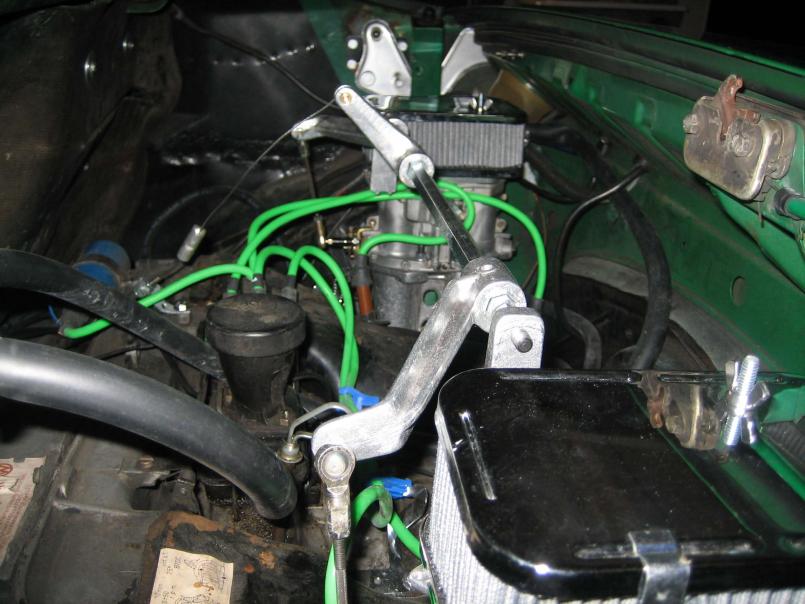
Posted by: Twystd1 Aug 8 2007, 03:16 AM
intake leak i sniff.
Is that an open vacuum port on the above pic?
CCC
Posted by: type11969 Aug 8 2007, 07:15 AM
Those should seal when screwed in all the way . . .
Posted by: terrymason Aug 9 2007, 03:13 PM
Success!!!
Problem 1 - I think that something was clogged up. I took both carbs off, and blew everything out with carb cleaner. It wasn't perfect when I put it back together, but after 5 minutes of driving, everything blew out and it ran great.
Problem 2 - looks like I cranked the pump volume adjustment too much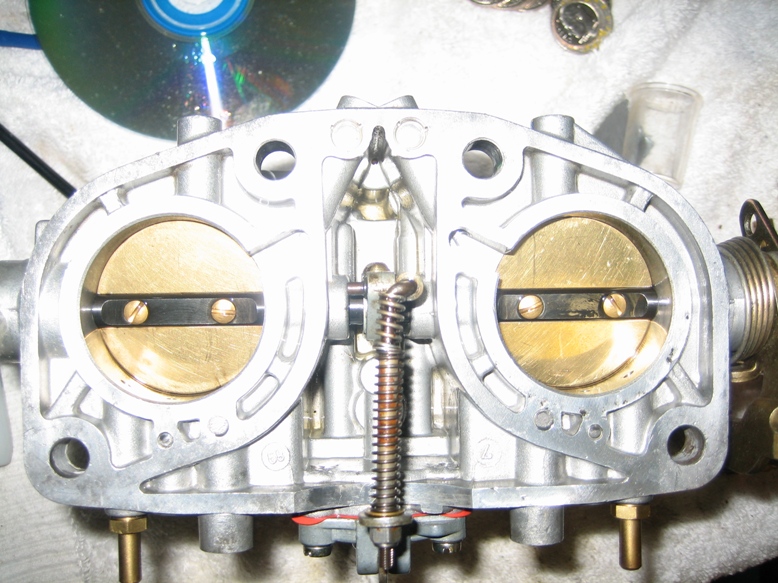
Posted by: Twystd1 Aug 9 2007, 07:22 PM
It will still run MUCH better if you toss that dizzy....
Clayton
Posted by: bjinright Apr 24 2008, 11:00 AM
So, Now what do you have running? I also have a 74 1.8 with dual dell's. Green as a matter of fact too. I have the same problem. Boggs down after idle (No stumble just sluggish 1500-3000) but then picks right up at 3000.
I am running.
32 VENTS
180 air
130 main
60 idle with the tall stacks
33 Pump
JAKE'S Mallory dizzy.
I know it's in the pump or idle. 55 idles were popping back everywhere so I went up to 60. No pops just boggy onder full accell.
Posted by: type11969 Apr 24 2008, 12:18 PM
33 pumps seem awfully small. Verify that they are indeed squirting fuel when twist the throttle shaft (look down the throat of the carb), i bet 33s can clog pretty easily. Should produce .2ccs per two throttle twists. I'm running 50 or 55 pumps on a 1.8 with dual dells and a mallory, hesistation is non-existant.
Posted by: terrymason Apr 24 2008, 01:38 PM
do you have a wide band o2 sensor? It made it ALOT easier to tell if the things rich or lean. I'm also running 30 vents now.
I'd say get bigger pump jets and swap them out. Pump jets are about the easiest to change.
Posted by: bjinright Apr 25 2008, 09:27 AM
do you have a wide band o2 sensor? It made it ALOT easier to tell if the things rich or lean. I'm also running 30 vents now.
I'd say get bigger pump jets and swap them out. Pump jets are about the easiest to change.
I've got some 35s I'll try them first, but I know I'll probable have to get the 50s. I SOLO race once a month or so so the O2 sensor is probably a good idea. I also need to check the etubes, I have no idea what they are. I was always looking for an f11 or f2 but I thanks to this thread I know what number to look for. We should put a thread on here for Dell's showing what a good starting point for different vents are. I've got the Tuning manual but it's very 1600 friendly.
My 1.8 is a eurospec. 8.5 to 1 compression. Factory carbed with wierd bumpers and no side markers. I don't know if it was originally that way but somebady before me made a darn good copy.
CB did not have 30's when I re-vented my dells so I'm sticking with the 32's. The 34's have an off idle stumble, (pretty common on our 1.8s and 2.0s) but if your racing who cares. The 32's have fixed the stumble.
Also Terrymason, I noticed the throttle body of your dell is similar to mine, If i saw it right there is a notch where the secondary vent fits in to the carb body. Not all dells have this. some 2vents have a ring around them like some kind of tiny space station. DO NOT order the update kit if you have the notch. It won't fit right.
OR tell CB that you have a notched Secondary vent body and see if they have another version. they haven't so far. My first set of Dell 40s had the update on them but were a different main body type apparently.
Posted by: type11969 Apr 25 2008, 10:05 AM
Its tough to find the right etubes, and they are expensive if you do. I found a place in the UK that had some but I think it was about 8 pounds per tube! The guy who sells dells on ebay in Italy (Alfa1750) was willing to exchange etubes but that means you won't have any for the weeks during shipping. You can always solder the holes shut assuming the etubes you have are close enough to the ones you want (can't remember the details, too lazy to flip back).
Why not just ream the 35s out to 50s?
-Chris
Posted by: bjinright Apr 25 2008, 10:52 AM
If I wasn't absolutely positive that I would screw that up, that's exactly what I would do. Are the reamer sets simple enough to use?
Until I put on the TALL idle stacks from CB. Everything was pretty much ok. I had 55 idles and 33 pumps. The tall idle towers popped and coughed me to 60s and I just haven't put the 35s in yet.
On another note. I read that you have the Mallory. What advence are you at? I'm at 30btd @ 3500.
Posted by: type11969 Apr 25 2008, 11:09 AM
Yeah, the reamer sets are simple, just take your time and use jet gauges to measure your progress. Kind of a big initial investment just to mess with your jets (to buy the reamers and the gauges) but definitely cheaper than buying a ton of jets.
Those idles seem pretty big although I can't remember what I am running now either. Ehh, whatever works. I'm pretty sure I am running 12 initial, 28 total, which is the spec that is recommended. I'll do some digging to see exactly what I am running.
Shortly before winter storage last year I installed the jet doctors from CB, didn't seem to change how the car ran at all though . . .
Posted by: bjinright Apr 28 2008, 09:29 AM
Finnally looked at my emo tubes. They looked sad ![]() Anyway they were .1 that have been soldered to .2 or .3 but I can't tell the difference between .2 and .3's Also the main airs are also a little taller than normal. CB tech book says that's OK though they also say pumps between 40 and 45 for us. You guys have 50s. Any smoke?
Anyway they were .1 that have been soldered to .2 or .3 but I can't tell the difference between .2 and .3's Also the main airs are also a little taller than normal. CB tech book says that's OK though they also say pumps between 40 and 45 for us. You guys have 50s. Any smoke?
Put on the 35s at lunch Friday. Got about another 10% of throttle before bog got me. Guess I'm goin to 50's.
Posted by: bjinright May 6 2008, 07:53 AM
Yeah, the reamer sets are simple, just take your time and use jet gauges to measure your progress. Kind of a big initial investment just to mess with your jets (to buy the reamers and the gauges) but definitely cheaper than buying a ton of jets.
Those idles seem pretty big although I can't remember what I am running now either. Ehh, whatever works. I'm pretty sure I am running 12 initial, 28 total, which is the spec that is recommended. I'll do some digging to see exactly what I am running.
Shortly before winter storage last year I installed the jet doctors from CB, didn't seem to change how the car ran at all though . . .
Ok the 50s are in. I'm not sure it's made a difference. The sound is different but the bog is still there. O2 sensor is next after I give 160 main airs a chance.
I already have 60 idles could i go up? That seems a little on the big side.
Posted by: type11969 May 6 2008, 08:24 AM
Going back to the first page of this post it looks like the difference between .2s and .3s is the max OD. If you have .1s soldered to match .2s then the OD should be fine (according to the .jpeg).
Are you sure all the idle jet passages and accel pump passages are clear? Do all 4 pump jets "fire" when you twist the throttle? One thing that can happen is that the little ball bearing in the accel pump passage no longer seals on its seat due to accumulated crud, if that happens, pressure in the accel pump passage bleeds off so next time you try to accelerate, nothing gets shot out of them.
60 idles seem really big, maybe you are running too rich and the bog is due to that?
I've never messed with the airs, what do you hope to accomplish by dropping down to 160s? All I know is that 180s are recommended so thats what I stuck with.
-Chris
Posted by: rhodyguy May 6 2008, 08:28 AM
remember, when you make a change to the idle jets you need to reset the idle air mixture screws and maybe tweak the the idle speed screws. i don't think you want to fatten up any further on the idle jets.
Posted by: bjinright May 6 2008, 12:11 PM
remember, when you make a change to the idle jets you need to reset the idle air mixture screws and maybe tweak the the idle speed screws. i don't think you want to fatten up any further on the idle jets.
Yeah, I'm not really going up on the idles until I get an A/F Gauge that says so.
I thought I would try 160's because the carbs are full open at low RPMS when the bog occurs. It would only take a minute to try, and I thought it might cut the air when i dump it open. This would be a separate experiment from any other fixes i try.
I'll check the pumps again. they are 50s now. how much should they flow per "squeeze"?
This all started when I put the tall Idle stacks on. I swear they are pulling more air. They are from the update kit not from the idle jet kit. Do you think there is a difference?
I'm having the oil changed, the carbs seals checked, the electrical checked, and they valve's adjusted this week. There was a race in Birmingham last weekend so I ussually take it in after for a once over
I'malso backing off on the dizzy to 27 total @ 3500.
Posted by: type11969 May 6 2008, 12:16 PM
.2ccs per two throttle pulls I think, its in the dell book.
I noticed no difference running the tall stacks. Maybe some crap fell into one of the passageways when you put the tall stacks on?
Posted by: rhodyguy May 6 2008, 04:03 PM
how low of an egine speed are we talking about when the carbs are "full open" and it bogs? like REAL low, you nail the gas and the car goes on it's nose til the engine catches up?
k
Posted by: bjinright May 6 2008, 04:28 PM
how low of an egine speed are we talking about when the carbs are "full open" and it bogs? like REAL low, you nail the gas and the car goes on it's nose til the engine catches up?
k
About 1500rpm. but it happens at 2000 and 2500 if I hit the gas. I'm not talking about slamming it from idle, just a full depression of the gas at low rpms. I get a little power back when I let off the pedal a bit and it wont bog under a slow progressive depression of the gas.
I had an off idle stumble back when I had 34vents. I think this is different.
It started 1 month ago and happened right after two events.
1. Went autocrossing and over revved the engine 7000 rpm a few times ( i was winning at the time)
2. put the tall idle stacks on when I got back that day (thought it was a clog and so made the change when I checked all the jets, and yes I used the little plugs)
So It could be that:
1. the timing was thrown off
2. the cam gear moved (unlikely)
3. the valve clearances are off or worse
4. the tall stacks blow more air (i know thats wierd)
I checked the timing . . . fine 30btdc @3500
The valves and cam gear are being looked at now. I think a have a stock cam by the way.
And I'm checking the dells for leaks.
Before it was fine with 55idles and 35pumps. But after sunday, pop cough bog. So I started going richer 60 idles then 50 pumps.
In week or two it will be back from the garage and I will have something to work with. A/F ratio meter, and valve adjust.
Posted by: rhodyguy May 6 2008, 04:35 PM
7k, do you hate your car? ![]() how old is the rebuild on the carbs? maybe axing stirred some junk in the bowls? undo the 2 changes prior to the prob. not to count over reving.
how old is the rebuild on the carbs? maybe axing stirred some junk in the bowls? undo the 2 changes prior to the prob. not to count over reving.
k
Posted by: bjinright May 6 2008, 04:59 PM
7k, do you hate your car?
k
The carbs are pretty new and this was my third autocross this year. I'll check the bowls again though.
Do you know how to get the little idle plugs out?
And NO I don't hate my car, I hate losing to Miatas.
BTW: Thanks to every body on this post for your input. I AM making progress. The car is getting better as I make these changes/checks.
Powered by Invision Power Board (http://www.invisionboard.com)
© Invision Power Services (http://www.invisionpower.com)

